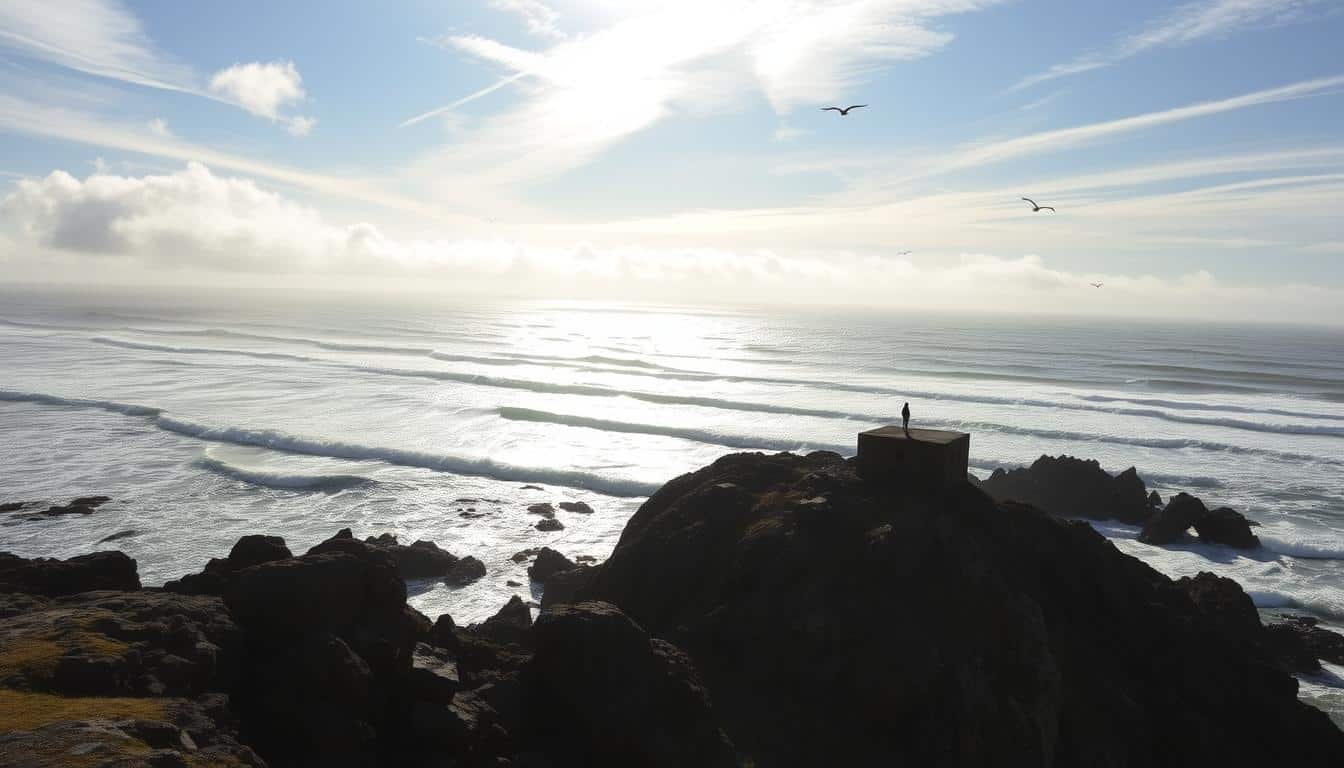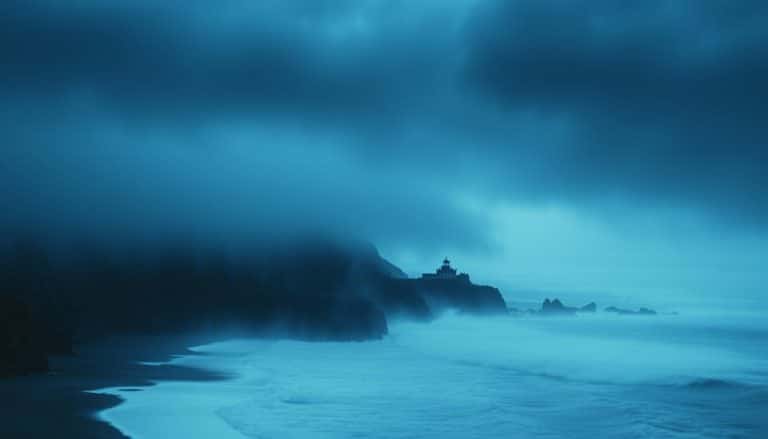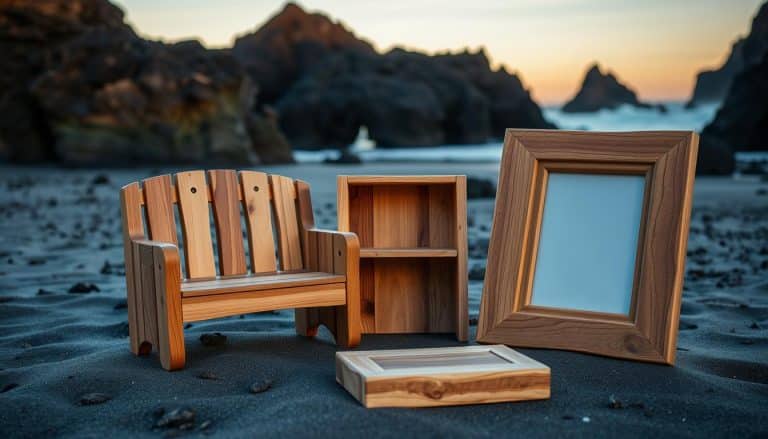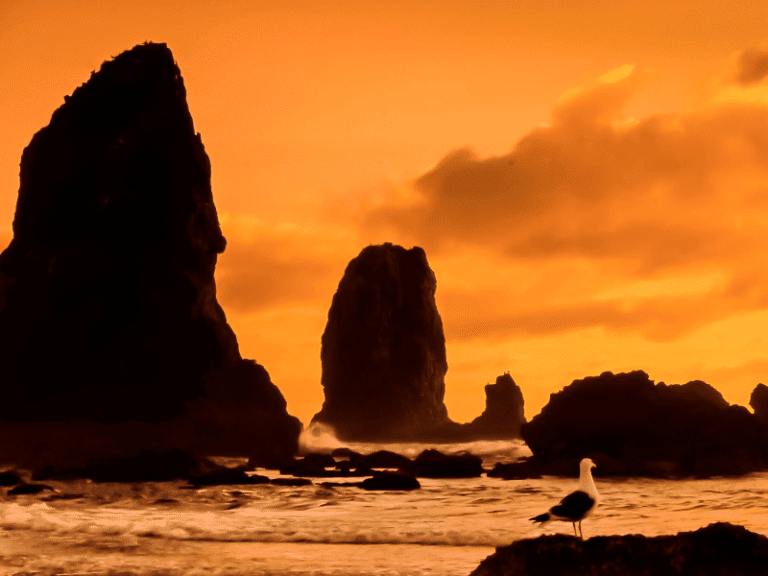From Lewis Clark to WWII Bunkers: Uncovering the Oregon Coast’s Layered Past.
This post may contain affiliate links. I may earn a small commission at no extra cost to you.
Welcome to a journey through time along the Oregon Coast. Here, history comes alive against stunning landscapes. We start with Lewis & Clark's epic journey, marking the beginning of Pacific Northwest exploration.
Then, we explore the enigmatic WWII bunkers. These bunkers silently stand as sentinels of a tumultuous era.
Exploring the Oregon Coast history is essential. Places like Tillamook Head are key. They show us how moments shaped our past. From historical landmarks to military history, each site tells a story.
Join us as we uncover the Oregon Coast's rich history. This is just the start. We'll explore events and landmarks that shaped today's Oregon Coast.
Key Takeaways
- The Oregon Coast is rich with historical layers from Lewis & Clark's expedition to WWII bunkers.
- Historical landmarks in Oregon, like Tillamook Head, are key to understanding Pacific Northwest exploration.
- WWII bunkers stand as silent reminders of the region's military history.
- The blend of natural beauty and historical significance makes the Oregon Coast a unique destination.
- This introductory overview sets the stage for a deeper dive into the region's fascinating past.
The Historical Significance of Tillamook Head
Tillamook Head is a stunning Oregon Coast landmark. It has amazed many for centuries. The Tillamook Head history goes back millions of years.
In 1806, the Lewis & Clark expedition reached Tillamook Head. They learned a lot about the Pacific Northwest. The views and terrain helped them see what lay ahead.
Tillamook Head also has stories of the sea. The Tillamook Lighthouse was built in the late 1800s. It helped ships navigate through dangerous waters.
The Tillamook Lighthouse history shows the bravery of those who built it. They faced harsh weather to help sailors.
Tillamook Head tells a story from deep in the earth to important historical moments. It includes the Lewis & Clark expedition and the Tillamook Lighthouse. It's a key part of the Oregon Coast‘s history.
An Introduction to World War II Bunkers on the Oregon Coast
Walking along the Oregon Coast's beaches and cliffs is peaceful. Yet, it's hard to forget the role it played in World War II. The coast has many hidden forts and war leftovers. Each one shares a story of bravery and planning.
Visiting these places connects us to the past. It shows us the military history of the Pacific Northwest.
The Mystery Behind the Tillamook Head Bunker
The Tillamook Head bunker is a mystery. It's hidden in the forest. It was built to watch the Pacific Ocean during WWII.
Today, visitors can see this place. They can picture the guards who watched over it back then.
The Function of the WWII Radar Station
The radar stations on the Oregon Coast were key in WWII. They helped spot enemy planes and ships early. This was part of a big defense system.
Places like Fort Stevens State Park show the military's presence. It has Battery Clark and Battery Pratt, among others.
Exploring the Oregon Coast: A Journey Through Time
The Oregon Coast is a stunning place. It has a rich history, from ancient rocks to the first European visitors. We learn about big changes and new discoveries here.
The Earliest Geological Formations
The Oregon Coast's rocks and cliffs are millions of years old. Volcanoes and earthquakes shaped this area. The coast's beauty shows Mother Nature's power.
The Arrival of the First Europeans
When Europeans first saw the Oregon Coast, it was a big moment. In the late 1700s, explorers like Captain James Cook mapped it. They brought new ways and changed the coast forever.
Let's look at who came first and what they did:
| Explorer | Arrival Year | Contribution |
|---|---|---|
| Captain James Cook | 1778 | First detailed charts of the Oregon coastline |
| Spanish Explorers | 1775 | Initial contact and trade with indigenous tribes |
Exploring the Oregon Coast's history and early visitors shows us its deep past. It also shows the ongoing spirit of discovery in this amazing place.
The Lewis & Clark Expedition and Its Impact
The journey of Lewis and Clark along the Oregon coast is very important in American history. They started exploring the Pacific Northwest in 1804. Their detailed stories helped the U.S. grow westward.
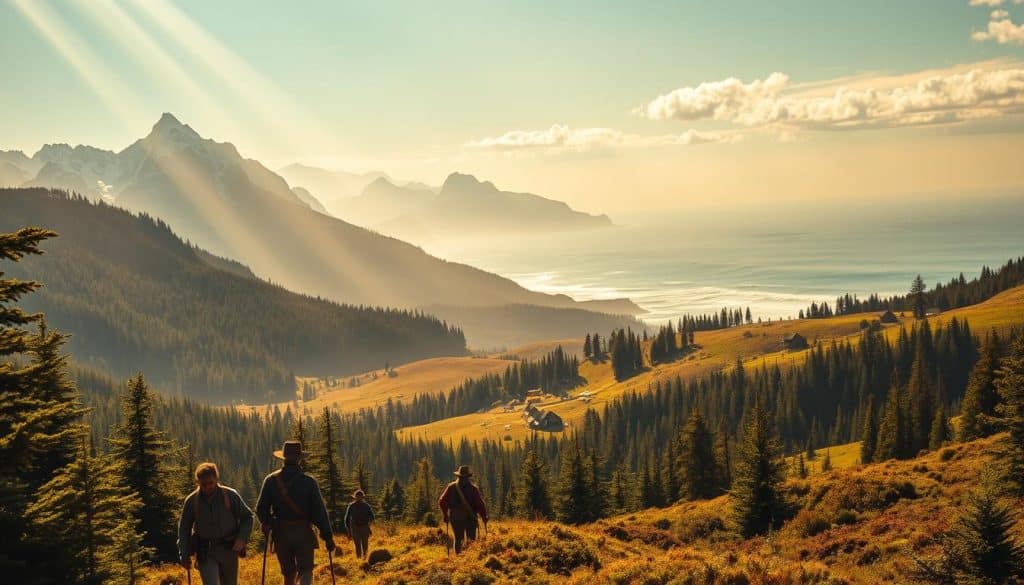
They met many Native American tribes, thanks to Sacagawea. She was a Shoshone woman who helped them talk to the tribes. She was a symbol of peace and understanding.
Lewis and Clark's findings helped the Pacific Northwest grow. They wrote about plants, animals, and the land. This knowledge helped others explore and settle the area.
Today, we remember their journey through Oregon's historical sites. These places honor Lewis, Clark, and Sacagawea. They show their bravery and hard work in exploring new lands for the U.S.
The Formation of Tillamook Rock Lighthouse
Tillamook Rock Lighthouse sits on a rocky island a mile off the Oregon coast. It has a fascinating history that shows the importance of maritime history in Oregon. This lighthouse helped keep sailors safe in the Pacific's dangerous waters.
Construction of the Lighthouse
The building of Tillamook Rock Lighthouse started in 1879. It was a tough job because of the bad weather. But the workers didn't give up. They finished the lighthouse in 1881.
This was a big achievement in lighthouse building. It showed how people can overcome hard challenges.
The Decline of the Lighthouse
At first, Tillamook Rock Lighthouse was very important for safety at sea. But new technology and changes in how people sailed made it less needed. By 1957, it was no longer used.
Now, it's a place of interest for those who love maritime history Oregon. It shows the lasting impact of coastal guides.
The Role of Fort Stevens During WWII
Fort Stevens is a big deal in Pacific Northwest defense history. It was a major military fort in the USA during WWII. It was at the mouth of the Columbia River in Oregon. This made it key in keeping the West Coast safe from enemy attacks.
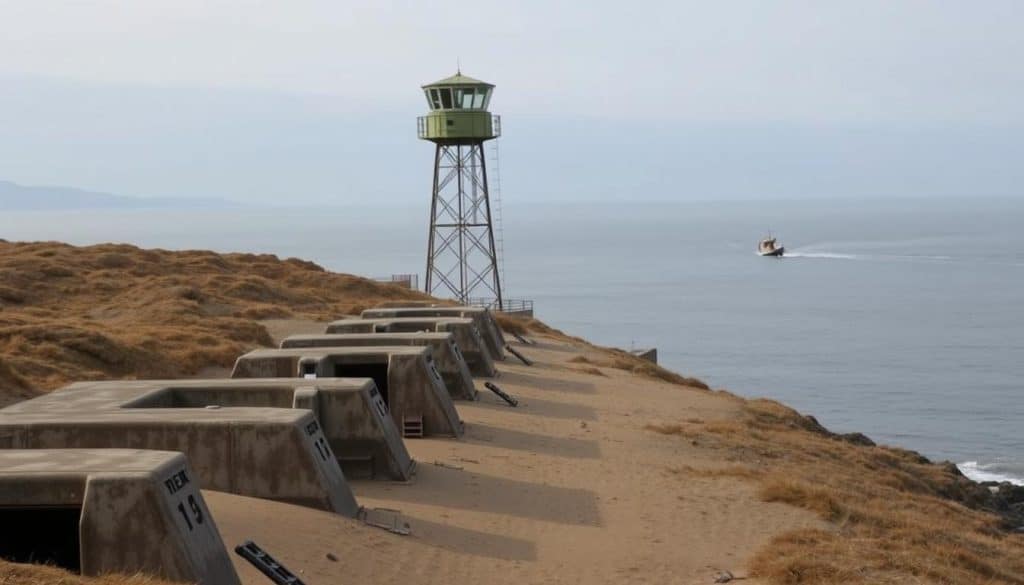
The Japanese submarine attack on June 21, 1942, was a big event at Fort Stevens. It was the only time an enemy attacked a US mainland military site during the war. Luckily, the damage was small. But it showed how real the dangers were for WWII Oregon.
During the war, Fort Stevens was busy with defense work. It had coastal artillery and anti-aircraft guns. The fort was ready for any threat.
- Seacoast Artillery Batteries
- Anti-Aircraft Guns
- Submarine Nets
- Radar Stations
These defenses helped keep the Columbia River safe. They also protected important shipping lanes. Fort Stevens was very important in Pacific Northwest defense history.
The story of Fort Stevens is a key part of WWII Oregon. It's also interesting for those who like military forts USA. Today, Fort Stevens is a place to learn and remember its past.
The Evolution of the Oregon Coastline
To understand the Oregon coastline's evolution, we must look at nature and human actions. The landscape has changed over time due to many factors. These include natural events and actions by humans.
Erosion and Deposition Over the Centuries
Coastal erosion Oregon has greatly changed the coastline over the years. Forces like waves, wind, and tides have reshaped the coast. Erosion wears down cliffs and rocks, while deposition builds new land like beaches and dunes.
These changes are part of a constant cycle that shapes the Oregon coast's geography.
The Human Impact on Coastal Changes
Humans have also changed the coast in big ways. Projects, cities, and tourism have sped up erosion. But, there are efforts to slow these changes and protect the coast.
These efforts, like fixing dunes and saving wildlife homes, are key. They help keep the coast's natural balance.
| Natural Processes | Human Impact | Conservation Efforts |
|---|---|---|
| Wave action and tidal currents | Development and urbanization | Restoring dunes and habitats |
| Wind erosion | Tourism | Protecting wildlife |
| Rock and cliff erosion | Coastal infrastructure | Sustainable interaction promotion |
| Deposition of sand and sediment | Pollution control | Balancing ecological needs |
The Strategic Significance of Oregon Coast During WWII
The Oregon Coast was very important during World War II. It had big coastal defenses to protect the western United States. The Oregon Coast WWII strategy included many plans and buildings to keep this area safe.
Defense Mechanisms and Preparedness
During WWII, the Oregon Coast got many defenses. Radar stations, bunkers, and towers were built to watch for enemies. Fort Stevens was key in keeping the coast safe, showing the strong defenses of the time.

Modern-Day Remnants and Memorials
Now, people can see the old military sites on the Oregon Coast. Places like the Tillamook Air Museum and Fort Stevens bunkers remind us of the war. These sites honor the sacrifices made and show the old defenses.
John Koch's Contributions to Oregon Coast Military History
John Koch is a well-known John Koch historian. He has helped us understand the military history Oregon Coast better. His hard work has made us appreciate the coastal defenses' role in World War II more.
Koch has worked hard to keep Fort Stevens history alive. He has documented its start, growth, and importance. This way, he makes sure we know how vital this place is.
He has also worked with museums and historical groups. Together, they have set up shows and classes. These help share the Oregon Coast's military history with more people.
Koch has written books filled with stories and memories from veterans. These books are great for both history lovers and experts. His work reminds us of the Oregon Coast’s military history and its role in defending the country.
Living Conditions at the WWII Bunker Camps
Life in World War II bunkers along the Oregon Coast was hard but also full of new ideas. Soldiers faced many challenges but also used cool military tech. This tech was key to their daily lives.
Daily Life of Soldiers
Soldiers in these bunkers didn't have it easy. Keeping their bunkers safe was a big job. They worked hard to fix and maintain them.
Food was simple, like canned goods and ration packs. But, the bond among soldiers kept their spirits high.
Technological Innovations of the Time
WWII military tech changed soldiers' lives a lot. Radar was a big help, spotting enemies early. It was big and needed constant care but was very important.
Also, new ways to talk to other units helped them work better together. This tech was a big help in keeping everyone safe.
In short, living in WWII bunkers was tough but soldiers were strong. They used new tech to stay safe and plan their next moves. This tech made the bunkers strong and helped keep the Oregon Coast safe.
The Transformation of Coastal Dunes and Estuaries
The Oregon Coast has changed a lot over time. Nature and people have worked together to change the dunes and estuaries. This has made the area very special.
Changes Brought by Human Settlement
People living here have changed the dunes a lot. Towns and farms have altered the land. Building things has leveled dunes and changed water flows.
This has hurt native homes. Now, we need to protect these places.
Natural Processes Shaping the Coast
But nature has been changing the coast for thousands of years. Wind and waves keep changing the dunes. Tides and rivers make estuaries move and change.
These actions keep the coast healthy and full of life. Knowing about these helps us protect the coast better.
The Oregon Coast is a unique place. It shows how nature and people work together. This makes the coast beautiful for us to enjoy.
Conservation Efforts to Preserve Oregon Coast History
Our journey through the Oregon Coast's history and beauty is special. Oregon Coast conservation keeps its natural and historical treasures safe.
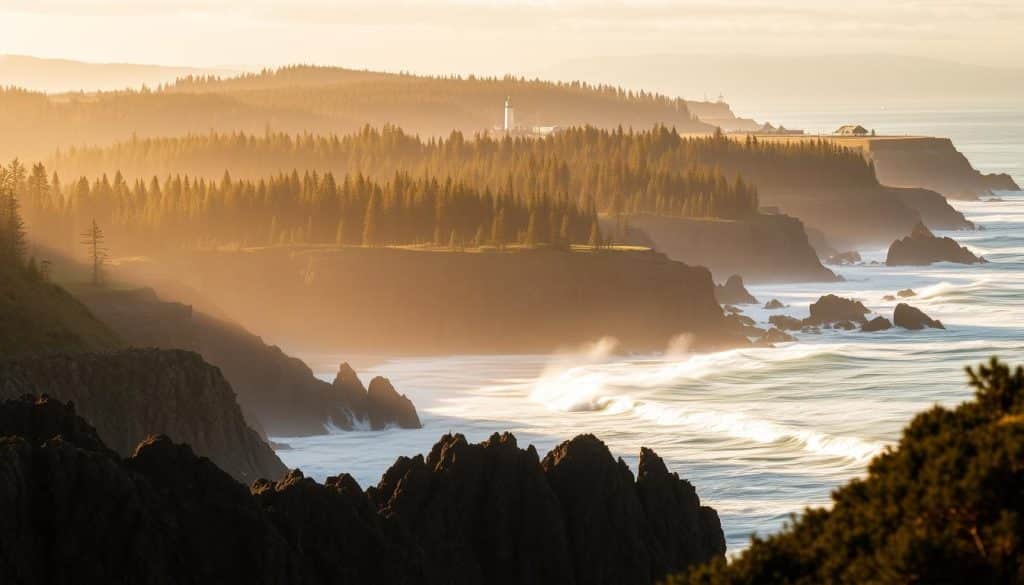
Groups like the Oregon Coast Alliance and the North Coast Land Conservancy lead the way. They protect the coast's ecosystems and history. Their work keeps the coast beautiful for the future.
These groups do many important things. They restore habitats, protect wetlands, and save historical sites.
- Restoration of native habitats
- Protection of wetlands and estuaries
- Safeguarding historical sites and landmarks
But, they face big challenges. Erosion, urban growth, and climate change are threats. Despite this, their dedication to natural heritage protection makes a big difference. The Oregon Coast stays a treasure for all to see.
| Organization | Key Focus Areas | Initiatives |
|---|---|---|
| Oregon Coast Alliance | Coastal Ecosystems, Historical Sites |
|
| North Coast Land Conservancy | Wetlands, Estuaries |
|
The Role of SCR-588 Radar Stations During the War
The SCR-588 radar stations along the Oregon Coast in WWII were a big step forward. They helped a lot with watching and defending against enemies. Let's look at how they were made, what they did, and the problems they faced.
Design and Functionality
The SCR-588 radar was a big deal in WWII. It could spot enemy planes and ships very well. It had strong senders and receivers, so it could see far away.
It worked in many kinds of weather. This made it even better for watching and defending.
Operational Challenges and Achievements
Even though the SCR-588 was advanced, it had many problems. Bad weather, technical issues, and needing constant fixes were big challenges. But the people who worked on them were very dedicated.
They kept the communication going, which helped a lot in the war. They caught enemy signals and helped plan defenses. These stations were very important.
| Aspect | Details |
|---|---|
| Primary Function | Detection of enemy aircraft and ships |
| Range | Long-distance coverage |
| Weather Adaptability | Operational in varied weather conditions |
| Operational Challenges | Harsh weather, technical malfunctions, maintenance needs |
| Achievements | Effective surveillance, improved military communication WWII |
The Connection Between Tillamook Head and Fort Stevens
Tillamook Head and Fort Stevens have a special link in Oregon Coast history. They worked together during World War II to protect the Pacific Northwest. Knowing how they helped us understand Oregon's military sites better.
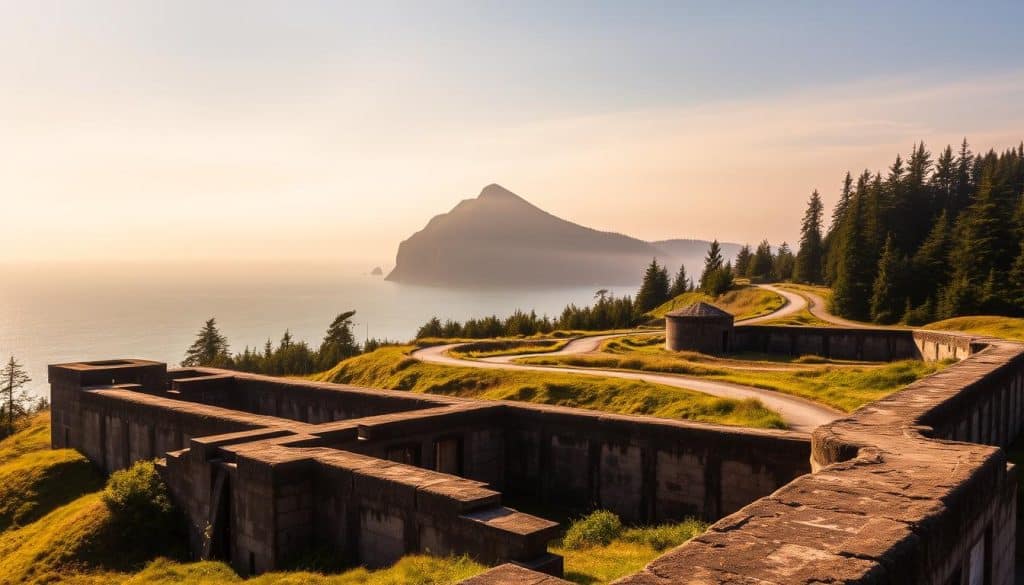
Tillamook Head was perfect for watching and warning of dangers. Fort Stevens was the main defense, with guns and strong buildings to keep invaders out. Together, they showed how important both places were for the coast's safety.
Exploring Tillamook Head and Fort Stevens is like stepping back in time. We see beautiful views and learn about our country's history. Walking these places, we feel connected to those who guarded our shores.
Modern-Day Tourism and Historical Sites
The Oregon Coast is stunning and full of history. It's a top spot for tourists. They can hike, visit museums, and learn about the area's past.
Popular Hiking Trails
The Oregon Coast has many hiking trails for everyone. The Cape Perpetua Scenic Area is famous. It has forests and ocean views.
The Samuel H. Boardman State Scenic Corridor is also loved. It has a rugged shore and beautiful views.
Museums and Educational Centers
The Oregon Coast has many educational museums. The Columbia River Maritime Museum in Astoria is one. It shows maritime history with cool exhibits.
The Tillamook Air Museum is another. It's in a World War II blimp hangar. It's all about aviation history.
| Museum Name | Location | Notable Exhibits |
|---|---|---|
| Columbia River Maritime Museum | Astoria, OR | Maritime history, ship models, interactive displays |
| Tillamook Air Museum | Tillamook, OR | World War II aircraft, historical blimp hangar |
Visiting the Oregon Coast is special. You can hike and see museums. It's a journey through time and nature. Every visit is unique in Oregon Coast tourism.
The Impact of Natural Disasters on Coastal History
Natural disasters on the Oregon Coast have changed the landscape and its people. Storms and earthquakes have shaped coastal communities. The environmental impacts are seen in the coastline's constant change.
Coastal resilience has grown with each challenge. Local communities now know how to recover from disasters. They have learned from past events to prepare for the future.
The Oregon Coast has faced many disasters like floods, tsunamis, and earthquakes. Each disaster has left its mark on the environment. It has changed the soil and plants.
Looking at past disasters helps us understand coastal resilience today. Historical sites and records teach us valuable lessons. They show us how to face today's challenges.
Conclusion
We've looked at the Oregon Coast's history and found many stories. These stories tell us about the Lewis & Clark Expedition and WWII bunkers. They show us the past in a special way.
These stories include amazing sights and human achievements. They invite us to learn more about Oregon's heritage.
We learned about Tillamook Head and how the coast has changed over time. We saw how WWII bunkers showed the region's strength. These facts show us a place full of beauty and stories.
This journey shows the Oregon Coast is more than a place to visit. It's a way to learn about history. This summary encourages you to explore more.
Go on trails, visit museums, and enjoy the coast. Each visit helps us understand and keep this heritage alive.


